
- Good for younger beardies
- Good for adult beardies

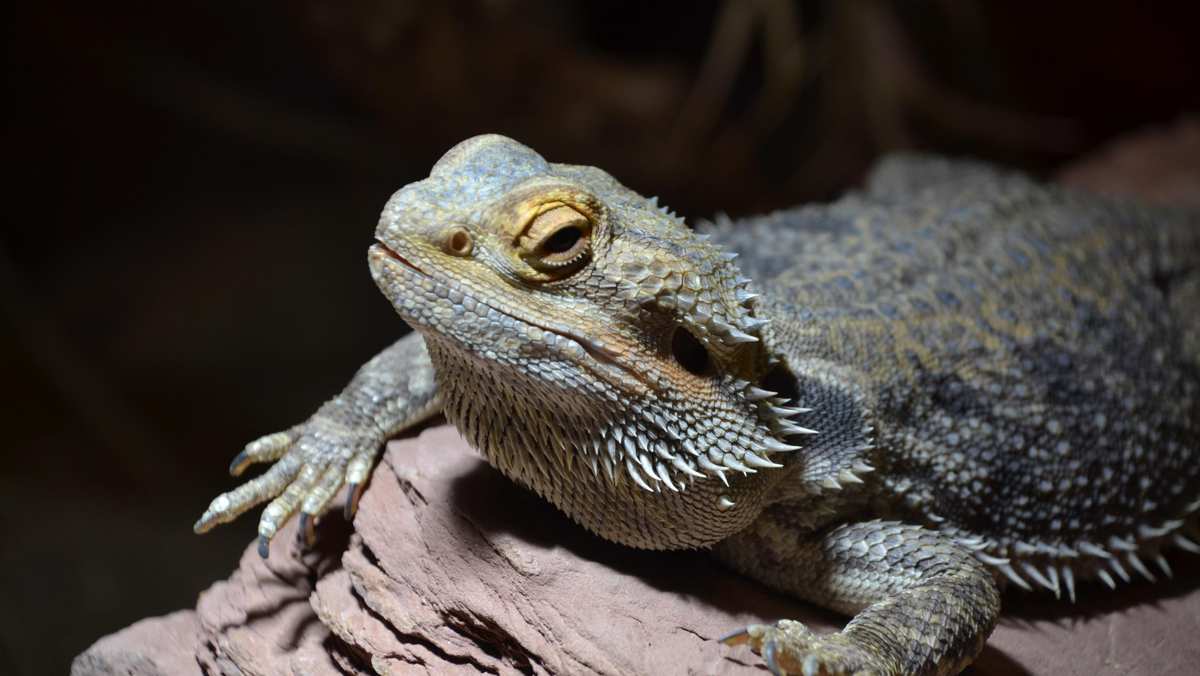
This is our complete bearded dragon care guide. It contains everything you need to know to be able to properly care for any bearded dragon regardless of age. This care sheet consists of all the valuable information that's available on our site, except we have put it into an easy to follow manual.
This care guide will start with the basics and will go through each step of bearded dragon care that people need to know to be able to raise healthy and happy bearded dragons.
Whether this is your first or tenth bearded dragon, choosing the perfect beardie is not an easy task. While it can be a bit overwhelming to choose a beardie, there are a few things to remember to make sure the bearded dragon you choose will be a perfect and healthy pet for you. Below is a brief overview of what to look for when choosing a bearded dragon.
There are many places that will gladly sell you a bearded dragon. Below are the common locations people get bearded dragons.
Pet stores are probably the easiest and most convenient place to get a bearded dragon. However, pet stores generally are expensive and don't have the variety of bearded dragon colors that are available in other places. There is also a concern that the bearded dragons within pet stores may not be as healthy as bearded dragons from private breeders.
Generally breeders will have many years of experience and have built ideal living environments for bearded dragons allowing them to produce extremely healthy bearded dragons in a multitude of exotic colors. While sometimes pricey, breeders are usually the only places bearded dragon enthusiasts will get their beardies.
If you're looking for a good deal, then you will probably have your best chances in classified ads either in the newspaper or on Craigslist. Usually you will find people who are moving or cannot care for their bearded dragon, so they are selling for a very low price (sometimes you will find people giving away their bearded dragons). Its not unusual to find complete bearded dragon packages where people are selling their bearded dragon and all of their bearded dragon supplies (tank, lights, etc.).
If you already have a bearded dragon (or if you've had one in the past), you should consider getting a rescued beardie. Not only will you be saving a bearded dragons life, but you will give the rescue more room for new animals and money to buy supplies. Since rescued bearded dragons can be more fragile (due to a potential history of neglect), you need to make sure that you have the experience and supplies necessary to ensure that he/she will be happy and healthy. View a list of reptile rescues
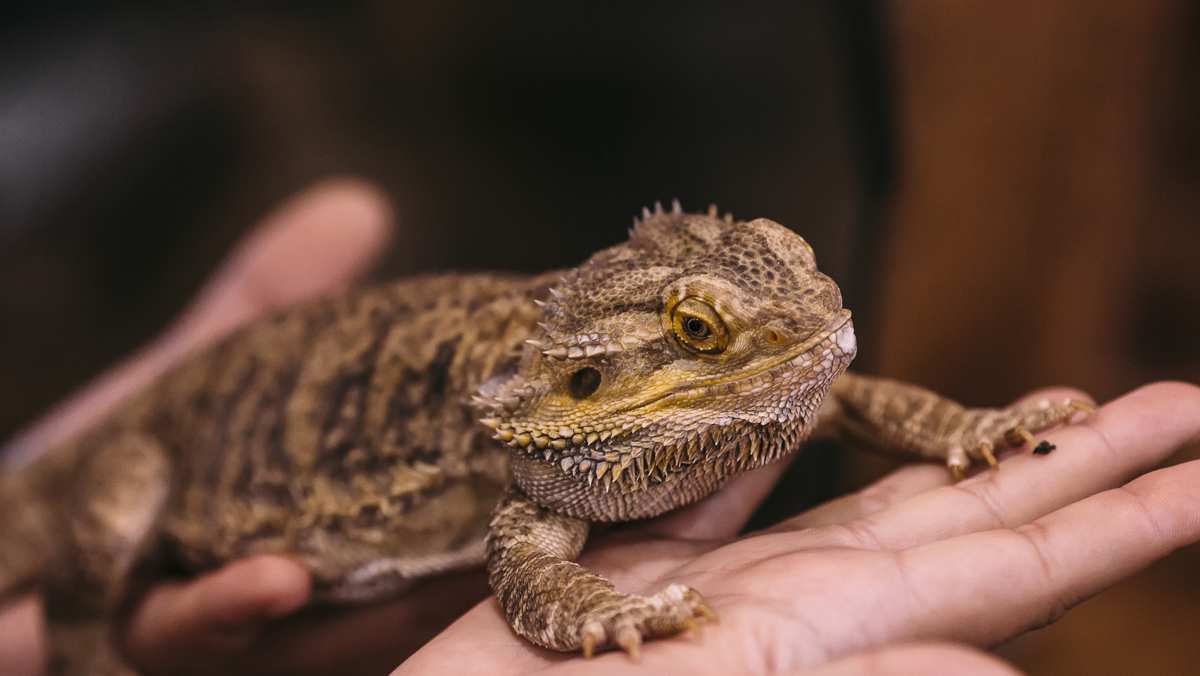
You will want to make sure that the bearded dragon you choose is healthy before your purchase. Fortunately, there are a few easy things to look for to determine the health of the bearded dragon you're wanting to buy.
Look for Past Injuries or WoundsCarefully inspect your bearded dragon. Look for any scars or signs of a past wound that could indicate future issues. If you do see a wound, make sure it has healed correctly and doesn't look infected.
Look for Missing Body PartsSome lizards can regenerate their body parts, however, bearded dragons cannot. If your bearded dragon is missing his tail or a limb he/she will stay that way forever. Keep in mind, it's not too unusual for a bearded dragon to be missing the very tip of their tail or a toe on their leg.
Look at Their HeadsLook for any puss or fluid around the bearded dragons mouth that could indicate a sick bearded dragon. You should also make sure that the bearded dragons eyes do not seem droopy and that their mouth and jaw are not swollen.
Check AlertnessHealthy bearded dragons are very alert. They do catch fast bugs for food after all. A perked up and active bearded dragon can be a clear sign of good health. However, keep in mind that not all healthy bearded dragons are active 24 hours a day. Many times very healthy bearded dragons will be tired and resting.
Should you get a young bearded dragon or a more mature beardie as a pet? This really depends on your needs. Normally young bearded dragons are cheaper, and since they don't have any previous owners you don't have to worry about any neglect.
However, young bearded dragons also require more care and attention as they will eat more bugs and rapidly outgrow their tank.
Older bearded dragons are easier to care for (they will eat more vegetables than bugs) and are less fragile than younger beardies. We generally recommend first time bearded dragon owners to start off with a young adult bearded dragon or older.
Bearded dragons are desert reptiles. In nature they live in a hot dry environment, so you will need to mimic their natural habitat to keep them happy and healthy. This section will cover exactly what you need to do to make sure your bearded dragon's home is not only an attractive addition to your room, but is also the ideal living environment for any beardie.
You will need to make sure your bearded dragon's tank is large enough for him/her to easily move around and feel at home. Too small of a tank can cause anxiety issues and can also negatively affect their growth. We have highlighted some general tank-size guidelines below. Keep in mind that you can't have too large of a tank, so it's always best to go bigger. The only drawback of having a very large tank is it will give their food (crickets, worms, etc.) more space to hide and will be harder to keep warm.
There are many different types of bearded dragon tanks. As far as tank-shape goes, you will want your tank to be a rectangle that is wide and shallow (about 16-20 inches in height). Below is a list of some of the different types of bearded dragon tanks that you can purchase.
These are by far the most popular bearded dragon tank, simply because they are the least expensive, good looking, and easy to get. The only issues with glass tanks is they are heavy (once you get it setup, you probably won't move it). They also do not hold in heat as well as other tanks, which isn't an issue but some bearded dragon hobbyists claim different tanks can help your beardies color seem more vibrant.
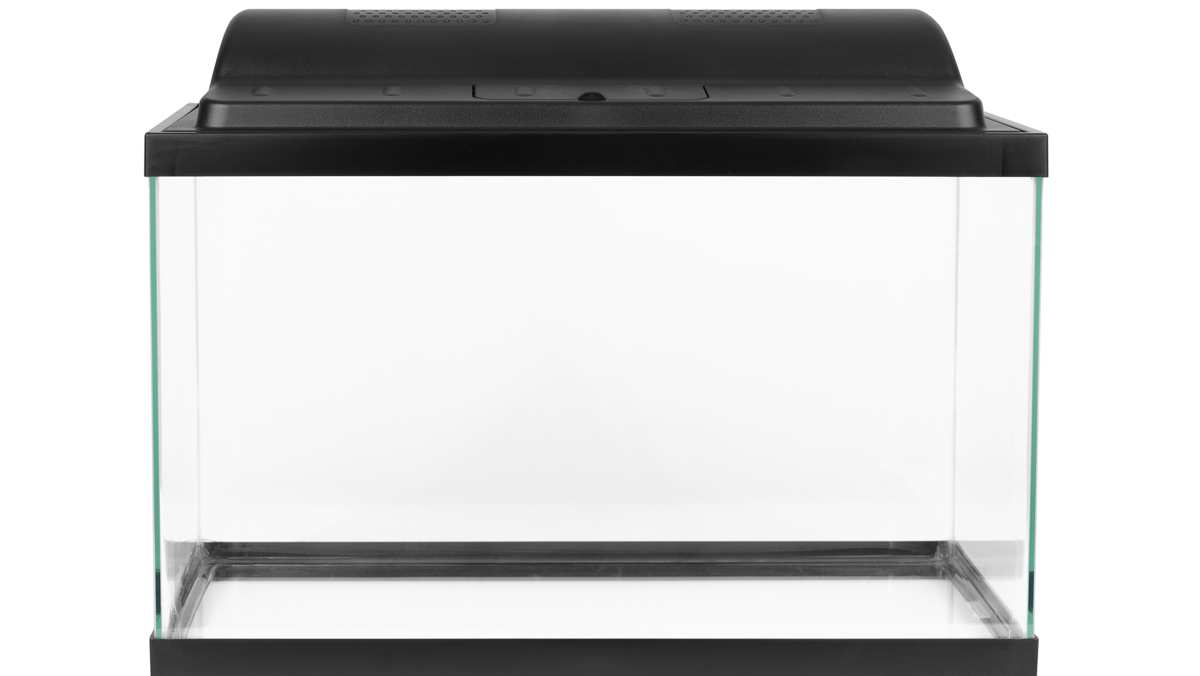
These tanks are made out of melamine board (a type of wood). You can purchase these tanks pre-made online or you can build the tank yourself by purchasing the wood at your local hardware store. Since the white boards reflect the light in the cage it makes your bearded dragon's color extremely vivid and some owners claim it makes their beardies happy too.
PVC cages are nearly identical to melamine cages, except instead of being made out of wood they are made out of PVC plastic. This makes the cages much lighter and easier to move. Plus you can easily stack PVC cages on top of one another to save space if you have multiple bearded dragons or other reptiles.
These are the cages that many bearded dragon breeders will use to display their beardies. This is because they are made out of molded plastic which gives you 100% viewing. Plus they are very easy to clean and come with built-in light fixtures. Like PVC cages, these are also very light and are easily stackable.
Besides the tank itself, you will also need accessories such as tank covers, lights, tank-flooring, etc. This section will go over everything you need so you can make sure your beardie has everything he/she needs to say healthy and active.
If you are using a glass tank (or a tank with an open top), you will need a screen cover. This tank cover will keep your bearded dragon from escaping and it will also keep other pets, insects, and objects from getting into the tank and harming your bearded dragon.
Your cover will need to allow air to easily flow in and out of your bearded dragon's tank. Do not use a solid plastic fish tank lid or any other tank cover that will restrict air flow. If air does not circulate it will cause too much humidity within your bearded dragon's tank which can make him/her ill. Because of this we highly recommend a good quality screen cover Zilla Fresh Air Screen Cover for your beardies tank.
Your bearded dragon will not get enough light from the room his/her tank is in (even if the tank is right next to the window). In order to give your bearded dragon the light he/she needs you will need to illuminate the tank with a UVA/UVB fluorescent light for 12-14 hours each day. Since bearded dragons are from the desert, they rely on the sunlight to stay healthy. This means you will need to use a full spectrum UV light (it provides all types of UV rays just like the sun). Don't forget, your bearded dragon will also need a basking light for warmth, so make sure both lights will be able to fit into the tank.
The most recommended full spectrum light is the Reptisun Full Spectrum Light. It will provide all the UV rays that your bearded dragon needs to remain healthy. Many owners claim that these lights not only make their beardies more happy, but it also helps with their color as well.
Again, bearded dragons come from a desert environment which means they like HOT temperatures. Your bearded dragon will need his/her tank temperature to be no cooler than 85°F and no warmer than 110°F. Do not use electrically heated rocks as they can burn and injure bearded dragons.
If your tank is large enough you will want to have a hot side and a cold side of the tank. Your hot side will be where the basking light is and the cool side will be the side without the basking light. You should monitor both the temperature and humidity of your beardies tank to make sure it matches their habitat as closely as possible.
A basking light is pretty much a heat lamp that focuses the heat into one specific part of the tank. It is very important to get a good quality basking light. Do not use regular house light-bulbs. The basking light will stay on for 10+ hours each day and will get very hot. The heat cause lower quality bulbs to burn out quickly and some to explode. Because of this we only recommend high quality basking light bulb such as Zoo Med's Basking Light Combo.
Since heat rises, under tank heaters (UTH) allow you to heat your bearded dragon's tank from the bottom. While these are not necessary, most bearded dragon owners will use them to keep their bearded dragon's tank warm overnight. Generally, you do not need a UTH at night unless the temperature falls into the mid 60's.
You will need a way to monitor the temperature and humidity of your bearded dragon's tank. You will want to keep the humidity as low as possible and the temperatures between 85°-110°F during the day and no lower than 65°F during the night.
Temperature and humidity gauges are fairly inexpensive, so it's recommended to get two thermometers (one for the cool side and one for the hot side) and one humidity gauge. A popular gauge of bearded dragon owners is a combination thermometer humidity reader, which display both temperature and humidity.
Your bearded dragon will also need some type of flooring for his/her tank. Most bearded dragon experts do not recommend loose flooring such as sand, wood chips, pebbles, etc. because bearded dragons can accidentally ingest the substrate which can cause impaction. Impaction is a very serious issue with bearded dragons and should be avoided at all costs. Because of this, we only recommend you use reptile carpet for your bearded dragon's tank. If you cannot get reptile carpet, you can also use newspaper, paper towels, or butcher paper.
Your bearded dragon will need a place where he/she can have some privacy. Having a hide will give your bearded dragon a place to feel secure as well as seek shade from the lights. You can purchase hides that resemble the natural rock hides that bearded dragons use in nature, or you can attempt to build your own hide.
Some owners feel their bearded dragon stays in the hide for too long and will remove their beardies hide during the day. However, it's recommended to keep your beardies hide in his/her tank 24 hours a day so your bearded dragon can use it whenever they're feeling tired vulnerable, or just want some alone time.
When choosing a hide, make sure it is large enough that your bearded dragon can move around once inside. If the hide is too small, your bearded dragon will not use it.
Bearded dragons love climbing and perching on various items to bathe in sunlight, so it's no surprise that beardies absolutely love reptile hammocks. These reptile hammocks use suction cups to easily attach to the inside of your beardies tank and can easily support even the heaviest bearded dragons.
As mentioned earlier, bearded dragons are great climbers so having a branch or two in your tank that your bearded dragon can climb and/or sunbathe on will not only add decoration to the tank, but it will also help to make your bearded dragon feel more at home. When choosing a branch, make sure it is thoroughly cleaned before you put it in your bearded dragons tank. If you're using natural wood, make sure all the bark is stripped from it (you don't want your beardie accidentally eating a piece of wood) and verify there are no holes that crickets can hide in.
A basking platform will be the place where your bearded dragon sunbathes beneath the basking light to get warm. It can be as simple as a rock, the top of your reptile's hide, or a tree branch. The best basking platforms will absorb heat and stay warm (like dark rocks), this way the basking platform will be warm to the touch which can warm your beardies underside while he/she basks beneath the light.
Bearded dragons are not used to walls and expect to see scenery in all directions. Because of this, many bearded dragon owners claim that their beardies seem happier and less grumpy when they use a tank background. Since plain painted walls are not in nature (and not impressive to look at), getting a background will help perk your beardies mood as well as improve the tank's appearance.
Feeding your bearded dragon the right food and keeping him/her on a diet will increase your beardies life span, increase the deepness of their color, and increase their mood. This section will go over what you need to know to make sure your beardie is nutritious and eating right.
Bearded dragons are omnivores, which mean they will eat both insects and vegetables. Your bearded dragon's diet will depend on his/her age. Younger bearded dragons will eat 80% insects and 20% vegetables, while adult bearded dragons will eat 20% insects and 80% vegetables. When you feed your bearded dragon you will need to make sure that none of the food is wider than the gap between his/her eyes. If an insect or vegetable is wider than the gap between your beardies eyes, then there is a high risk of him/her choking and/or getting injured. So before feeding your bearded dragon you will need to verify the vegetables or fruit are cut into small enough pieces and none of the insects are too large.
Young bearded dragons are quickly growing, and because of this they will require much more insects than fruit and vegetables. Many owners claim that it is sometimes difficult to get younger beardies to eat their vegetables, so you should leave the vegetables in their cage during the day while they're awake. You should feed your bearded dragon as many crickets as they can eat within a 10-15 minute period three times per day. After 15 minutes you should remove any uneaten crickets from your bearded dragon's cage. On average, expect your bearded dragon to eat anywhere between 20-60 crickets (or other insects) per day.
Adult bearded dragons will eat much less insects than younger dragons. This is less exciting to watch, but it is a lot cheaper! If you overfeed an adult bearded dragon he/she can easily become overweight or unhealthy. Adults main diet will be vegetables, but once per day you will want to feed them insects. You will feed adults insects the same way you feed younger bearded dragons. Once per day feed them as many crickets/insects they can eat within a 15 minute time period. After 15 minutes remove the food form their tank.
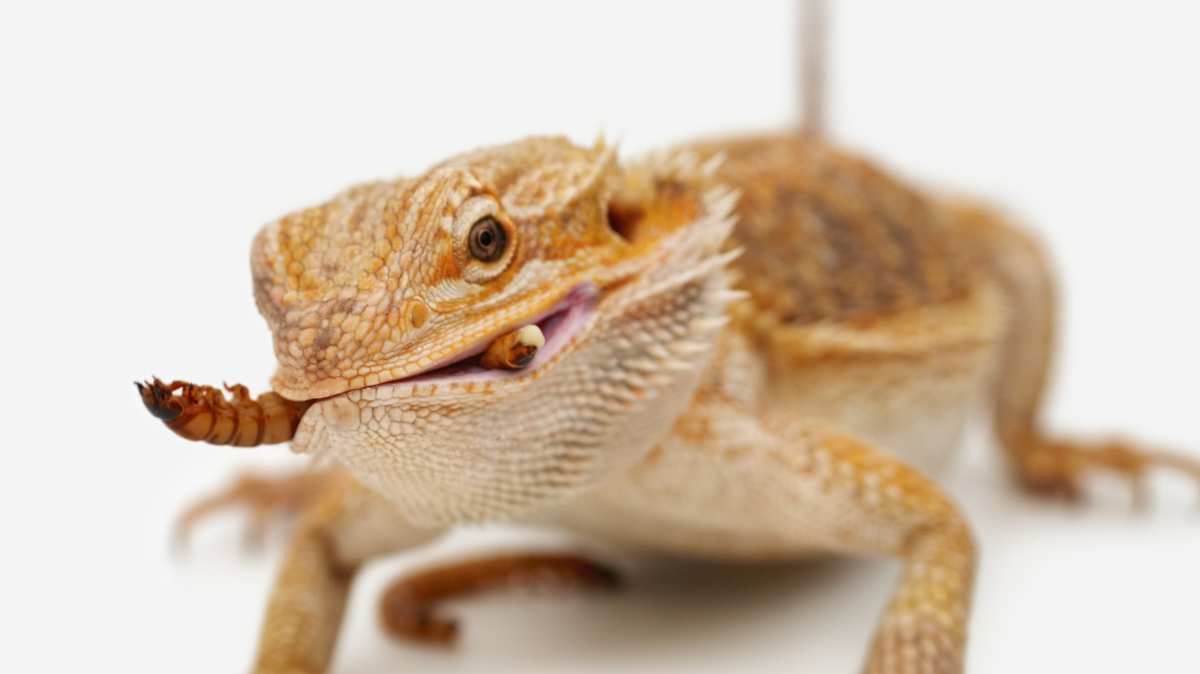
Bearded dragons will eat just about any bug that crawls in front of them, so it is up to you to make sure the bugs they are eating are safe and nutritious. First off, you cannot feed bearded dragons bugs you find around your house or bugs that you purchase at a bait shop to fish with. This is because bugs can carry parasites as well as insecticide which can be lethal to bearded dragons. You should only feed your bearded dragon insects that have been bred specifically for feeding pets. You can buy these bugs at most pet stores, but it is much cheaper and easier to buy them from insect breeders online.
Below is a list of the most popular healthy bugs to feed to bearded dragons. Next to each bug you will see notes for both young and adult bearded dragons.








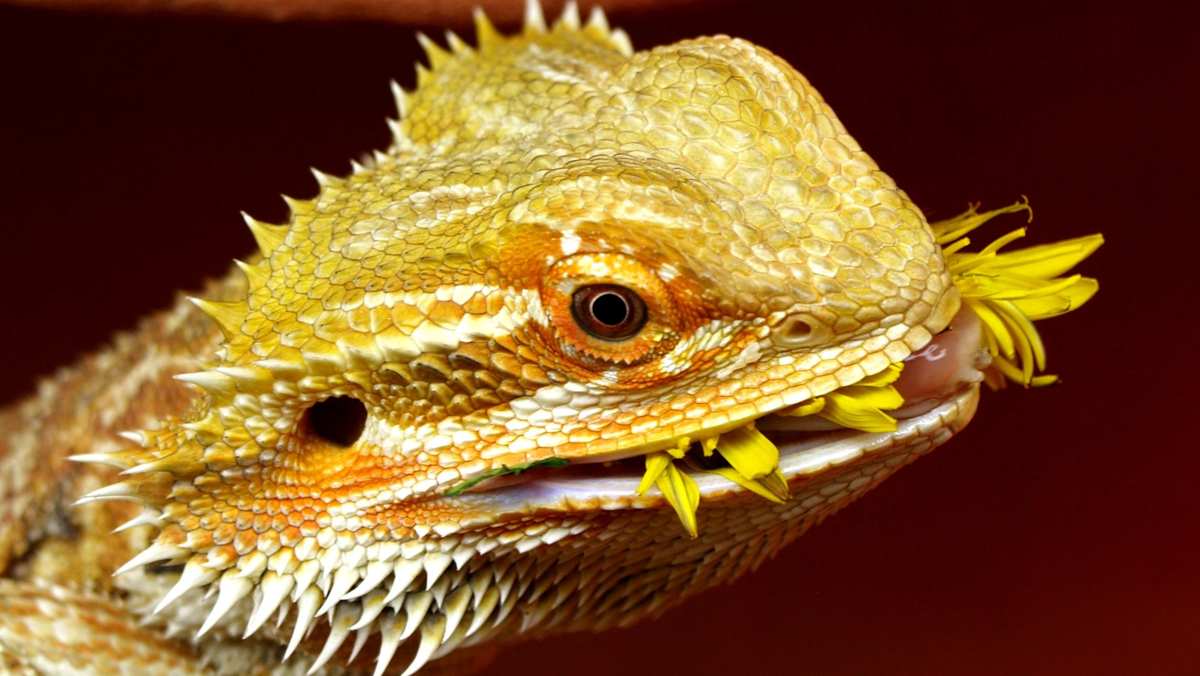
Compared to watching your bearded dragon eat insects, plants are pretty boring. However, plants are a major staple of your bearded dragon's diet. The fruit and vegetables you feed your bearded dragon contain the vitamins and minerals needed to keep your beardie healthy.
Below is a list of some of the most popular and favorite vegetables for bearded dragons. You can feed your beardie any of these vegetables on a daily basis. To view a full list (as well as nutritional information) of all the vegetables you can feed bearded dragons, we recommend checking out our Safe Vegetables for Bearded Dragons list.
Fruit can make a bearded dragon's meal more tasty and can help entice picky bearded dragon's to eat their vegetables. Below is a list of some of the most popular fruits bearded dragon owners feed their beardies. To view a full list, take a look out our complete Safe Fruit for Bearded Dragons list.
There are many foods which are either unhealthy or dangerous for bearded dragons to eat. Below is a list of foods that you should avoid feeding your bearded dragon.
AvocadosAvocados are toxic for bearded dragons. While their toxicity levels are unknown, they are poisonous enough to be lethal for birds.
Fireflies & Glowing InsectsIf an insect can make itself glow, never feed it to your bearded dragon. The chemical that causes these bugs to glow is lethal to bearded dragons.
Insects Captured in the WildDo not feed your bearded dragon bugs that you've caught yourself. Insects caught in the wild can contain parasites and pesticides which can make your bearded dragon very sick.
LettuceLettuce isn't necessarily dangerous for bearded dragons, but it's not healthy either. Since lettuce provides zero nutritional value for bearded dragons it is recommended to avoid feed it.
SpinachSpinach is healthy and nutritious, but calcium binds to it which makes it difficult for your bearded dragon to digest. Because of this it is recommended to avoid feeding your bearded dragon spinach.
There are many plants which veterinarians consider unhealthy or dangerous for bearded dragons. Many of these plants can be found in residential areas or as house plants. There are too many varieties to list here so we suggest reviewing our full list of poisonous plants for bearded dragons.
Your bearded dragon will need vitamins and minerals to remain healthy. This section will go over what you need to know to make sure your beardie received the right amount of vitamins and minerals.
There is a lot of confusion over vitamin A with bearded dragon owners, because too much can cause vitamin A toxicity. Many bearded dragon owner fear that if they feed their beardies foods which are high in vitamin A (such as carrots) that their bearded dragon can receive toxic levels of A-Vitamins. Fortunately, this is not the case. In fact, most all cases of vitamin a toxicity in bearded dragons is caused when people give their bearded dragons multivitamins which contain synthetic vitamin A. Symptoms of too much vitamin A (Hypervitaminosis A) include swollen eyes, throat, and body as well as lack of energy.
When bearded dragons eat fruits and vegetables they are getting vitamin A in the form of Beta Carotene. Beta carotene is not toxic to bearded dragons and if they eat too much, they can simply excrete it from their body without any negative effects. Synthetic vitamin A, which is found in many reptile multivitamins, cannot be excreted by bearded dragons and is instead immediately absorbed into their body. Generally bearded dragons will receive a good amount of vitamin A from the vegetables they eat, so giving your bearded dragon synthetic vitamin A after they eat vegetables will force their body to absorb even more vitamin A which can poison their body.The best way to make sure your bearded dragon is getting enough vitamin A without risking them getting sick is to use a reptile multivitamin which uses Beta Carotene instead of synthetic vitamin A. This way your beardie will simply excrete the Beta Carotene if their body doesn't need any vitamin A.
By far the most popular multi-vitamin for bearded dragons is Herptivite Multivitamin for Reptiles as it ensures your bearded dragon will receive the vitamin-A he/she needs without risking vitamin A toxicity.
Usually bearded dragons will get enough iron from the vegetables they eat. However, younger bearded dragons will need more iron than adult beardies. Since younger dragons eat less vegetables you may want to consider using an iron supplement to make sure your bearded dragon is getting the iron he/she needs to grow and stay healthy.
Calcium and vitamin D3 are two of the most important vitamins and minerals you need to make sure your bearded dragon has. These nutrients help bearded dragons develop strong bones and are important for gravid female dragons (carrying eggs). Bearded dragons cannot absorb calcium without vitamin D3 so you will need to make sure they receive both nutrients simultaneously.Bearded dragons naturally receive vitamin D3 from sunlight, but since they are mostly indoor pets you will need to give them a vitamin D3 supplement to make sure their body is getting the nutrients they need. If your bearded dragon is in frequently in direct sunlight or has a full spectrum UV light, you can reduce the dosage by as much as half.The amount of vitamin D3 and calcium your bearded dragon needs depends on his/her age. The table below shows general estimates of how much the average bearded dragon would need:
Most vitamin D3 and calcium supplements will also have phosphorous. You don't want your bearded dragon to have too much phosphorous so its best to purchase a vitamin D3 and calcium supplement with low phosphorous levels (ratio of 2:1, 3:1, or higher).Currently the best vitamin D3 and calcium supplement available is Rep-Cal Reptile Calcium Powder with D3, which contains zero phosphorous and is a favorite among reptile breeders and enthusiasts.
Bearded dragons are very resilient and healthy animals, however there are still a few health issues that you should be familiar with. This section will cover common bearded dragon behavior and health issues so you can make sure your bearded dragon is healthy.
Before you immediately assume your bearded dragon's ill, make sure their behavior is normal. Below is a list of common behavior from bearded dragons that may cause alarm with inexperienced owners.
Think of brumation as a hibernation cycle for bearded dragons. Bearded dragons will respond to the changes in temperatures and lighting by brumating in the late fall or early winter. During brumation a bearded dragon will become less active and have a decreased appetite. It's not uncommon for bearded dragons to sleep for days at a time and skip countless meals. During the brumation cycle your bearded dragon may get up every once and a while to eat and move around, but for the most part they will rest.
Brumation is completely different for each bearded dragon. Some bearded dragons will brumate for a week, others for a few months, and some will never brumate. Since each bearded dragon's brumation cycle is different, it causes many inexperienced owners to assume their bearded dragon is sick. One day their bearded dragon will eat well and then he/she will nap for 5 days straight without eating.
If you're concerned your bearded dragon's not eating enough during brumation, you can weight them on a scale (in grams) and monitor their weigh throughout their brumation cycle. Healthy bearded dragons weight will not fluctuate during brumation. It is recommended, however, to not wake your bearded dragon when he/she is in brumation. Doing so can cause a lack of rest which can extend their brumation cycle. Learn more about brumation
Depending on your bearded dragons age, he/she will shed anywhere from twice a year to once every few months. As you can imagine, since younger bearded dragons are constantly growing they will shed much more regularly than adult bearded dragons.
When a bearded dragon begins to shed, their color will dull and their eyes will seem more puffy than normal. Most dragons will shed without any issues, but it is recommended to bathe them regularly to help them shed. Try to resist helping them shed by picking at loose skin. If you peel off their skin too early it can damage the new skin. If you want to help, try using a damp warm washcloth to gently exfoliate the already loose skin that is barely attached to their body. Learn more about bearded dragon shedding
Bearded dragons will usually behave differently when they're not feeling well or if something's wrong. This section lists the most common bearded dragon issues that you should know about.
If your bearded dragon is eating regularly he/she should also have a regular bathroom schedule. If your beardie has eaten well, but has not used the bathroom for several days, it could be sign of an impaction issue.
Most minor impaction issues can be helped by gently massaging your bearded dragon's stomach in a warm bath. However, more serious impactions will require medical care from a reputable herp vet. Learn more about impaction
Diarrhea can be caused by change of diet, stress, or bad food. It shouldn't cause concern if it happens every now in then, but if it's a regular occurrence it could be a sign that something's wrong such as parasites or worms.
Since the bearded dragon's environment is very dry and very hot, proper hydration is very important. You can tell if your bearded dragon is dehydrated by gently pinching their skin with your fingers and letting go. If the skin doesn't return to normal instantly, it's a sign that they are dehydrated. Other signs of dehydration include sunken eyes, wrinkled skin, lack of energy, and a lack of appetite. Learn more about dehydration
Droopy eyes is when your bearded dragon's eyes begin to droop (similar to a bloodhound's eyes). Droopy eyes can be caused by kidney issues in bearded dragons. If you suspect your bearded dragon has droopy eyes, it is recommended that you contact your local vet.
Paralysis is a serious issue that is most commonly caused when your bearded dragon eats something too large to digest. Whenever a bearded dragon eats food larger than the space between its eyes it puts pressure on his/her spinal cord during digestion. If the pressure on their spinal cord lasts too long it can cause paralysis or even death. Learn more about paralysis
If you suspect your bearded dragon has eaten an item too large and has become paralyzed then you should immediately contact your local vet, because the paralysis can be reversed if your bearded dragon receives quick medical care.
If bearded dragons don't receive proper diet, lighting, or temperature they can develop certain diseases. Below is a list of the most common disease in bearded dragons.
If your bearded dragon's habitat is too cold or too humid, he or she can develop a respiratory infection. Symptoms of a respiratory infection include gaping mouth, breathing difficulties, puffy body and/or throat, excess mucus around the mouth and nostrils.
MBD is the weakening of the bones in your bearded dragon and is caused by a lack of calcium, vitamin D3, and/or phosphorous. Symptoms of MBD include: bumps in the legs that you can see/feel, swollen lower jaw, jerky movements, twitches and spasms, as well as bumps in the vertical columns of the back and tail. Learn more about metabolic bone disease in bearded dragons
Fortunately metabolic bone disease can be treated with proper diet, temperature, and UV light. You can also treat MBD with the right bearded dragon multi-vitamin.
Mouth rot is a yellowish/white substance that will appear in and around your bearded dragon's mouth. Usually your bearded dragon will have a decreased appetite if he/she has mouth rot since their mouth can be swollen and their teeth can be loose. It is recommended to take your bearded dragon to a local herp vet if you suspect your beardie has mouth rot.
This section will go over the basics of general bearded dragon care.
Just like people, bearded dragons needs to be bathed frequently. There are many benefits to bathing your bearded dragon including keeping him/her clean and hydrating your bearded dragon as beardies will often drink bath water more than their water dish.
You can bathe bearded dragons as often as once per day, but most bearded dragon owners will only bathe their bearded dragon this frequently to aid in bowl movements. Some bearded dragons will not defecate in their tank, but will only go when they are given a bath. However, it is recommended to bathe your bearded dragon once every four to eight days. Of course, if your bearded dragon is dehydrated, is constipated, or is shedding you should bathe him/her more frequently to help. If your bearded dragon does defecate in the bath, you should remove the fecal matter quickly so you do not contaminate the bath water (remember most beardies will drink their bath water).
In nature, bearded dragons receive moisture on their skin every day from the morning dew, and it is recommended to mist your bearded dragon's cage each morning to replicate this. By misting their cage you will also reduce the number of baths you need to give your dragon.
Water Temp - Bearded dragons are reptiles, which means they are cold blooded, so they will need very warm water. The ideal temperature of the water should be around 94-96 F°. While bearded dragons can swim, you should never fill the bath where your bearded dragon cannot easily keep his head out of the water. Ideally the water should be no higher than his/her elbows on their front legs (usually about 1-2 inches deep depending on the size of your dragon).
Bathing Location - You can bathe your bearded dragon in a bathtub, sink, or even in a large Tupperware container. As long as you can easily rinse off your beardie then it's okay. However, it is more fun to watch the dragon swim around in bathtubs. Keep in mind that you will need to thoroughly clean whatever you bathe your dragon in both before and after you give your beardie a bath.
The Bath - You should let your bearded dragon bathe for 10-30 minutes. You may need to add more warm water to the bathtub to keep it a comfortable temperature for your bearded dragon. Some dragons will like baths more than others and if you feel bathing your bearded dragon is making him/her stressed, you should consider putting a rock in their bath so they can take a break. You may notice that your bearded dragon inflates their belly when they are in the bath, this is normal and they do this to help keep them buoyant. If your dragon is shedding, you may want to gently rub the problem areas (toes, feet, tail, etc.) with a soft brush or a washcloth.
After Bathing - After you've bathed your beardie you will want to dry him/her off with a soft dry towel. Many owners will do a quick cleaning of their beardies tank before putting their now clean bearded dragon back into his/her tank.
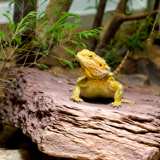
Learn what you need and how to set up the perfect bearded dragon tank.
Go to the Previous Page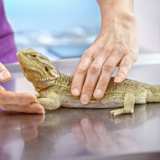
Learn common health issues with bearded dragons and how to keep your beardie healthy.
Go to the Next Page